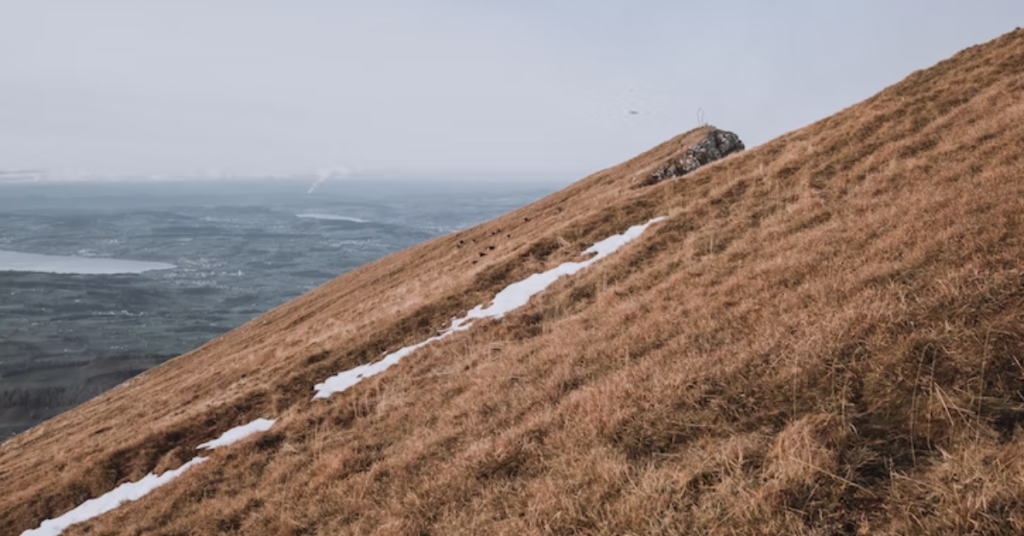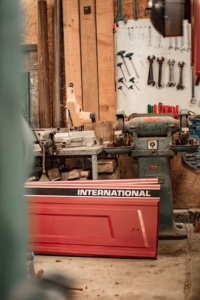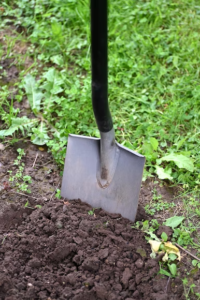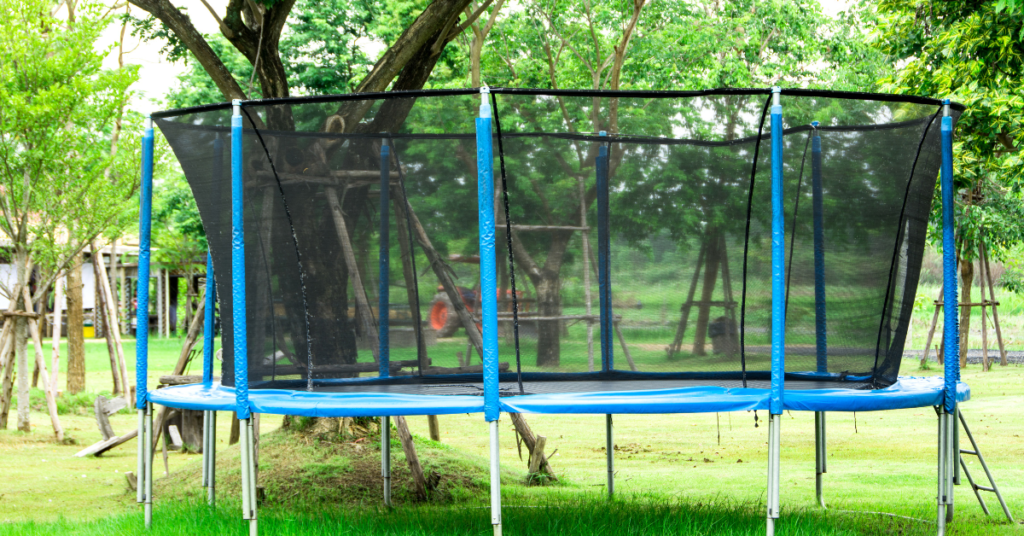Can a trampoline be installed on uneven ground? Luckily the answer to this is yes. However, it is suggested to have it fixed on a smooth and flat surface to have secure bounces. Trampolines are the best option for having fun along with a workout; jumping on them could be dangerous if it is a little uneven.

Thus fixing a trampoline on a slope requires more time than installing a normal trampoline on a flat level. Not just that, it requires more money and a different hand, which could even be of a professional if you are not good enough with tools.
The process differs when it comes to installing a trampoline on a hill or a slope. If there is a minor slope, the higher side’s legs will be sunken into the ground to balance the effect; if it is a significant slope, the land must be balanced out.
Steps to Put a Trampoline On a Slope or Hill or An Uneven Surface
1. Examining the Slope of Your Backyard
First and foremost, you need to calculate the extent of your slope, whether it is a deep one or a minor one. It is suggested that the max should be around 20% of the gradient or below or equal to 7.
For the comparisons, you need to first calculate the diameter of the slope either in inches or meters; however, you find it feasible but make sure they have to be in the same unit.
The tools you will require to measure the slope are a wooden plank, a carpenter’s level, and a measurement tape.
The Process To Determine The Slope

- Grab a wooden plank at first, more extensive than the size of your trampoline.
- Then, locate the trampoline where you want to install it.
- Now place the carpenter’s level and plank on the trampoline parallel to each other.
- Next, balance the bubble on the carpenter’s level by placing the wooden plank on the downside portion of the slope.
- Finally, measure the distance between the top of the downward side with the top of the trampoline.
- After the measurement, calculate the trampoline’s diameter and go for the same unit, like inches.
- Furthermore, compare the trampoline’s diameter with the distance between the trampoline and the plank.
- After dividing the diameter by the space above, match the results; see if it is equal to or less than 7. It is perfect for getting started if it is below or equal to 7. Otherwise, you need to look for another site for your trampoline.
2. Dig The Channel

After managing pre-installation formalities; its time to elaborate on some practical working here, and for that, you need to:
Firstly get the trampoline to where you want to install it and decide where to harrow the trench to adjust the uphill leg of the trampoline.
Considering the previous measurements of the slope you calculated, dig the trench about the same depth as the slope, and take help from the carpenter’s level to balance the status.
To check if the ground is stable, place the trampoline with uphill legs inserted in the channel you dug, and see if the other portions are taller than the uphill legs of the trampoline. It results in a bit of stability of the trampoline base.
Afterward, dig a few more channels into balancing out the other legs of the trampoline. The moment you find the trampoline completely balanced. That’s the point! Let the other legs get settled on those points.
If you see a little unbalanced edge, try digging more or less to make it flat equally from each side. Do not worry if it is a little bit uneven, and it will eventually be balanced when you start jumping on it.
If it is not comfortable enough after all these efforts, you better need to change the trampoline place.
3. How To Fix A Bumpy Surface

Ultimately, installing a trampoline anywhere, whether on an uneven surface, slope, a hill, or even flat ground, wouldn’t be possible; it has to be even and balanced. You can not insert a trampoline on a bumpier or uneven basis. We have a couple of ideas to balance out the base of a trampoline.
3.1 Trampoline Leveler
Trampoline leveling kits help balance out the ground by working as an additional extension to the legs of the trampoline that helps maintain a good balance.
First, determine where you want this extension to be added and install it. Then, check the balance after inserting it, so you do not have to face difficulty afterward.
3.2 Leveling Boxes
Leveling boxes are usually made for cars, but they can be a great help in balancing trampolines.
Doubtlessly it is accessible and the cheapest option available. You can add these boxes as much as you want to balance the trampoline, but they should be added where the legs are sinking deep.
Few of the boxes provide additional services as ten interlocking blocks. They are constructed with a durable material yet still weightless.
3.3 Cutting The Edges Of Trampoline

Cutting the edges of the trampoline is not a suggested activity, as the process itself can be a little hard and damaging if you are unaware of the tools. Moreover, the main catch is that once cut, the legs can not be redeemed back; you need to ensure the leg you are trimming is the exact size you want.
Let’s go through the process of cutting the edges.
- Drag the trampoline where you want to fix it.
- Measure the height of the trampoline’s leg from the ground with a measuring tape.
- Judge which leg needs to be trimmed to have a balanced trampoline.
- Not just the cutting of legs, you need to dig the ground to make a complete balance of the trampoline.
- Use a saw carefully to trim the legs and a shovel to dig the ground.
- End the process by inserting the trampoline and checking if it is up to your wish!
3.4 Drawback Of Cutting the Legs
Again, never go for this option unless you are not left with any other choice. You cannot reverse the action once you have trimmed the legs.
Let’s put it as if the ground changes its form due to heavy rain or other related reasons, and the trampoline might become unstable again and unbalanced. At the same time, the legs have been cut according to the previous measurements, and they might become useless. So then you have to trim back the legs again either or fill the ground up with stuff to make it stable.
Another thing to be cautious about is that not everyone can use the tools as fluently as a professional can. So if you mess up a little, it might result in the trampoline becoming useless. In
In contrast, you might hurt yourself, too, by using sharp, edgy tools.
3.5 More Digging Of The Place
This process is a bit longer as you have to harrow a hole for the legs and the complete trampoline; if you plan on having an in-ground trampoline, this is your best choice. If you see a little unbalanced, get yourself a shovel and stating harrowing deep as per your adjustments.
Benefits Of A Stabilized Ground

The surroundings must also be considered when planning to insert a trampoline anywhere around. For example, it is in a place with rocks, which might cause severe injuries if a kid or anyone falls onto it. Are there any branches at a lower level that might hurt you and your kids when they have a good bounce on a trampoline? How about the ground levels?
Although this article covers the trampoline over derelict land, let’s account for some benefits of flat ground and drawbacks of a base with a slope.
Pros of a flat surface
- It provides more power in the bounces.
- It is indeed more fun with secure jumps.
- It provides a safe strength for a jumper to bounce higher and ensure a safe landing.
Meanwhile,
Cons Of Sloppy Edge
- If the trampoline is sloppy, you might get pulled away to the lower side of the trampoline resulting in slipping.
- Automatically the bouncer will be attracted to the slightly low side.
- The trampoline side with a lower level would have more jumps than an inclined side. This uneven weight distribution would result in the trampoline being worn out.
Objects To Consider Before Installing A Trampoline:
To get fun along with the security and the view, you need to consider all these relative effects, even if the sight is sloppy or flat.
A Neat Surrounding
The foremost thing you need to consider is the nearby things; it could be a pool, a tree with a lot of scattered branches, any ceiling, a fence, or anything that would come intact with the jumper while bouncing and creating severe harm.
Change the position of the trampoline if you see anything like this to avoid accidents.
Type Of Grounds

Soft ground has always been preferred as a base for the trampoline. This is because trampolines play safe on a smooth floor, the bounces are more secure, and the trampoline works better on soft ground. Also, considering the landing, there are fewer chances of being hurt if you fall on soft ground rather than hard ground like concrete or gravel.
Still, if you go for a rigid base, you must take certain precautions, placing a layer of a rubber mat under the trampoline or going for a rubber cover for the feet of the trampolines.
A Perfect Size
Before buying a trampoline, always check on two things, like always. Firstly, who is going o use it? Secondly, what is the size of your backyard, or where do you want to get it? If you wish to get it for a kid, always prefer a small or mini trampoline considering you have enough space for alternatives; however, if you want it for an adult and have a large backyard go for a bigger one.
Types of Trampolines
- Round Trampoline
- Square Trampoline
- Rectangular Trampoline
- Oval Trampoline
- Octagon Trampoline
- Hexagon Trampoline
Furthermore, the selection of the right size of a trampoline is a must. Finally, you must select the trampoline that best settles in your backyard. It can either be with a stand or an in-ground trampoline. Both types can work flawlessly if you wish to have them fixed on flat ground. In contrast, the one with the frame helps better adjust itself on uneven land.
Enclosing The Trampoline
Last but not least, always Enclose the trampoline with a net, no matter what type or shape of the size it is so; having an enclosure net always ensures safety when you are bouncing without worrying. It saves you from accidents, whether an adult or a kid jumping around a trampoline. Even if you are 100% alert and cautious, a little mixed balance can let you land hard or fall off the trampoline; the enclosure net assures you are safe within the trampoline.

3 thoughts on “How To Install A Trampoline On Uneven Ground?”